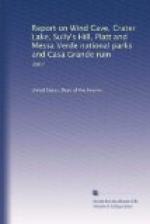LOCATION AND CHARACTER.
The Casa Grande ruin, situated near Gila river, in southern Arizona, is perhaps the best known specimen of aboriginal architecture in the United States, and no treatise on American antiquities is complete without a more or less extended description of it. Its literature, which extends over two centuries, is voluminous, but of little value to the practical scientific worker, since hardly two descriptions can be found which agree. The variations in size of the ruin given by various authors is astonishing, ranging from 1,500 square feet to nearly 5 acres or about 200,000 square feet in area. These extreme variations are doubtless due to difference of judgment as to what portion of the area covered by remains of walls should be assigned to the Casa Grande proper, for this structure is but a portion of a large group of ruins.
So far as known to the writer no accurate plan of the Casa Grande ruin proper has hitherto been made, although plans have been published; and very few data concerning the group of which it forms a part are available. It would seem, therefore, that a brief report presenting accurate plans and careful descriptions may be of value, even though no pretention to exhaustive treatment is made.
HISTORY AND LITERATURE.
The earlier writers on the Casa Grande generally state that it was in ruins at the time of the first Spanish invasion of the country, in 1540, and quote in support of this assertion Castaneda’s description of a ruin encountered on the march.[1] Castaneda remarks that, “The structure was in ruins and without a roof.” Elsewhere he says that the name “Chichilticale” was given to the place where they stopped because the monks found in the vicinity a house which had been inhabited by a people who came from Cibola. He surmises that the ruin was formerly a fortress, destroyed long before by the barbarous tribes which they found in the country. His description of these tribes seems to apply to the Apache.
[Footnote 1: Castaneda
in Ternaux-Compans. Voyage de Cibola. French
text, p. 1, pp. 41, 161-162.
(The original text—Spanish—is
in the
Lenox Library; no English
translation has yet been published.)]
The geographic data furnished by Castaneda and the other chroniclers of Coronado’s expedition is very scanty, and the exact route followed has not yet been determined and probably never will be. So far as these data go, however, they are against the assumption that the Chichilticale of Castaneda is the Casa Grande of today. Mr. A. F. Bandelier, whose studies of the documentary history of the southwest are well known, inclines to the opinion that the vicinity of Old Camp Grant, on the Rio San Pedro, Arizona, more nearly fill the descriptions. Be this as it may, however, the work of Castaneda was lost to sight, and it is not until more than a century later that the authentic history of the ruin commences.




